Kitchen and Bath Design: Blending Functionality with Style
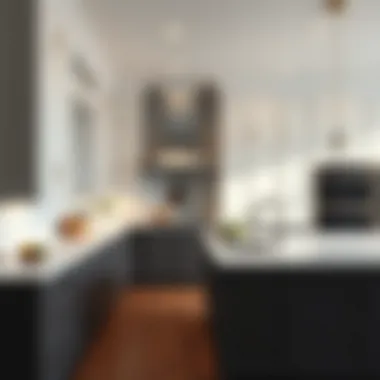
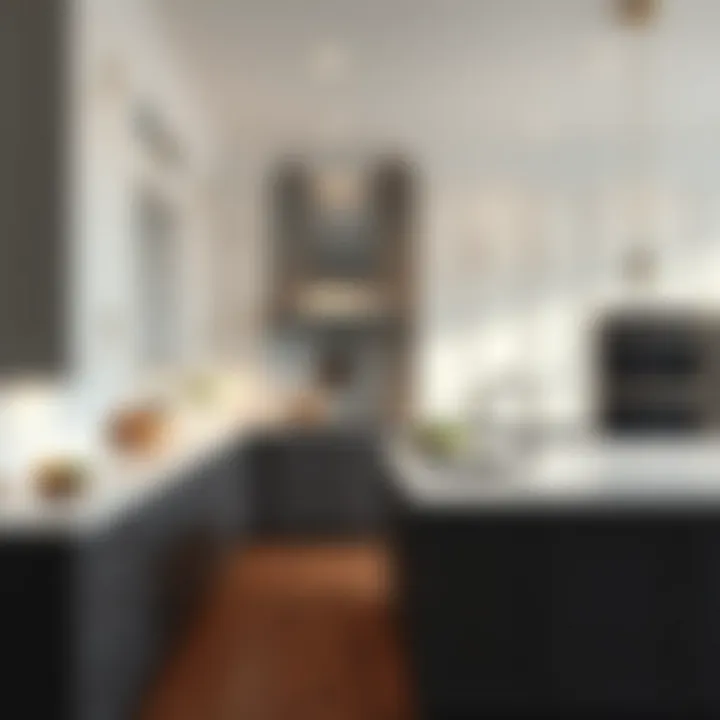
Intro
When one thinks of a home, the kitchen and bath often arise as the two most used spaces. These areas serve as more than mere functional zones; they can express style and reflect personal taste. The balance between utility and aesthetic appeal becomes crucial in any design project regarding these rooms. In today’s fast-paced world, creating a corner that melds beauty with practicality can be a significant pursuit.
Reimagining these spaces—especially kitchens and bathrooms—can transform your daily routines into enjoyable experiences. The way one designs these areas can enhance both their lifestyle and well-being. Each decision made, from color choices to material selection, plays a role in how inviting and functional these environments become. This article aims to guide homeowners and design enthusiasts through the essential elements of kitchen and bath design, giving them insights to create personal retreats that not only serve daily needs but also elevate the aesthetic of their home.
Design Inspirations
Creating a stunning kitchen or bath begins with understanding your design inspirations. This can range from modern minimalism to rustic charm, a style that resonates with the homeowner's vision of their space.
Trending Styles
Today's design trends often reflect a blend of comfort and sophistication. Some styles gaining momentum include:
- Scandinavian Minimalism: Known for its clean lines, functional layouts, and natural materials, this style focuses on simplicity while offering warmth.
- Modern Farmhouse: This trend brings together vintage elements with contemporary comforts, often involving white palettes combined with barn-inspired materials.
- Industrial Chic: Exposed bricks, raw metals, and high-contrast colors can create a striking backdrop, signaling a blend of urban sophistication and rustic touch.
These styles showcase the adaptability of kitchen and bath design. The essence is to choose the distinctive elements that resonate most with personal taste, leading to a space that feels both inviting and uniquely yours.
Color Palettes
Color plays an unequivocal role in the overall feel of a room. A well-chosen palette can breathe life into spaces while setting moods that encourage relaxation or stimulation.
- Warm Neutrals: Shades like beige, taupe, and soft creams create a cozy and inviting atmosphere perfect for cooking or winding down.
- Bold Accents: Incorporate colors like deep emerald green or navy blue as accents to make a statement without overwhelming the senses.
- Soft Pastels: Light hues, including mint or pale pink, can evoke serenity and pair beautifully with natural wood elements.
Choosing colors that harmonize well with the overall design theme of the home will help create fluidity across spaces. The secret lies in picking a few dominant colors and integrating them throughout the spaces for a cohesive look.
"A well-designed room should feel like a natural extension of its occupants.
Product Recommendations
Creating your dream kitchen and bath also hinges on the right product selections. From decorative elements to essential fixtures, these products can elevate your design.
Bath Accessories
Depending on the style, accessories can range from modern sleekness to decorative vintage finds. Consider:
- Quality Towels: Soft, absorbent towels can enhance comfort. Opt for larger sizes for a more luxurious feel.
- Stylish Storage: Baskets or elegant jars can keep essentials organized while adding visual interest.
- Sustainable Products: Eco-friendly options not only look good but also promote a healthier environment.
Bedroom Essentials
Although bedrooms are separate from the core focus of kitchens and baths, adding elements harmoniously enhances overall home design:
- Luxurious Bedding: High-thread count sheets and plush duvets can turn a simple room into a sanctuary.
- Ambient Lighting: Use dimmable lights or bedside lamps to create the perfect mood.
- Personal Decor: Framed photographs or artwork that resonates with you create a sense of belonging.
Foundations of Kitchen and Bath Design
The foundation of kitchen and bath design is paramount to crafting spaces that harmoniously blend functionality and aesthetic appeal. At the heart of effective design lies the understanding of space, use, and personal style. These foundational elements serve not just to beautify, but also to enhance the livability of the home. The kitchen, often termed the heart of the home, and the bathroom, a personal sanctuary, require thoughtful consideration in their planning and execution.
Effective space planning is crucial; it transforms a mere room into a functional area where activities flow with ease. Understanding how people move through and use these spaces enables designers to optimize layouts. Moreover, foundational principles guide the choice of materials, color schemes, and amenities, ensuring they work in concert to create a cohesive environment that meets the specific requirements of daily life.
Thus, grasping the foundations of kitchen and bath design is not merely academic. It directly benefits homeowners by improving their experience within these essential spaces. When a home is designed with intention, it becomes a personalized haven tailored to the needs of its occupants. The following sections will delve deeper into the intricacies of space planning and key design principles that underpin effective kitchen and bath design.
Understanding Space Planning
Space planning is the blueprint of any design project. It focuses first on how a space will be used, determining which areas will serve specific functions. In kitchens, for instance, it’s about identifying work zones that include cooking, cleaning, and storage. Placing these areas in suitable locations minimizes unnecessary movement, thus promoting efficient workflow. In bathrooms, the planning phase involves considering the placement of key fixtures such as sinks, showers, and toilets to maximize functionality and comfort. This pragmatic approach not only makes daily routines more manageable but also elevates the visual appeal of the space.
Key Design Principles
Design principles form the bedrock upon which functional and beautiful spaces are constructed. These principles include balance and harmony, functionality and flow, as well as proportion and scale. Each plays a crucial role in achieving a well-rounded design.
Balance and Harmony
In design, balance and harmony create a sense of equilibrium and cohesiveness. Rooms that reflect these qualities feel more inviting and visually appealing. A key characteristic of balance is the distribution of visual weight. This can manifest through the placement of elements like cabinetry and appliances. For instance, in a well-balanced kitchen, larger items may be balanced by the arrangement of smaller decor pieces. This creates a visual rhythm that guides the eye organically through the space. The beauty of striving for harmony is that it invokes comfort and encourages relaxation, especially in spaces like bathrooms where tranquility is desired.
Functionality and Flow
Functionality focuses on the practical aspects of designing a space, ensuring that each element serves a purpose. It should not be underestimated, as it directly affects how efficiently a space operates. Flow, on the other hand, relates to the ease one experiences while moving through a space. A kitchen designed with clear paths and logical transitions between different zones enhances the cooking experience, whereas a bathroom with easy access to fixtures leads to improved daily routines. A design that prioritizes functionality and flow promotes a better quality of life.
Proportion and Scale
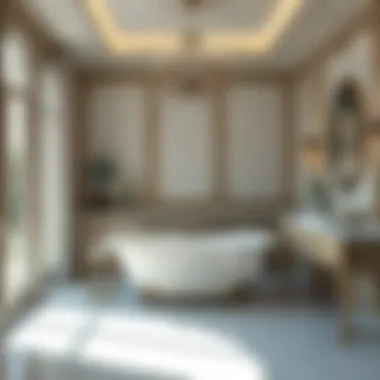
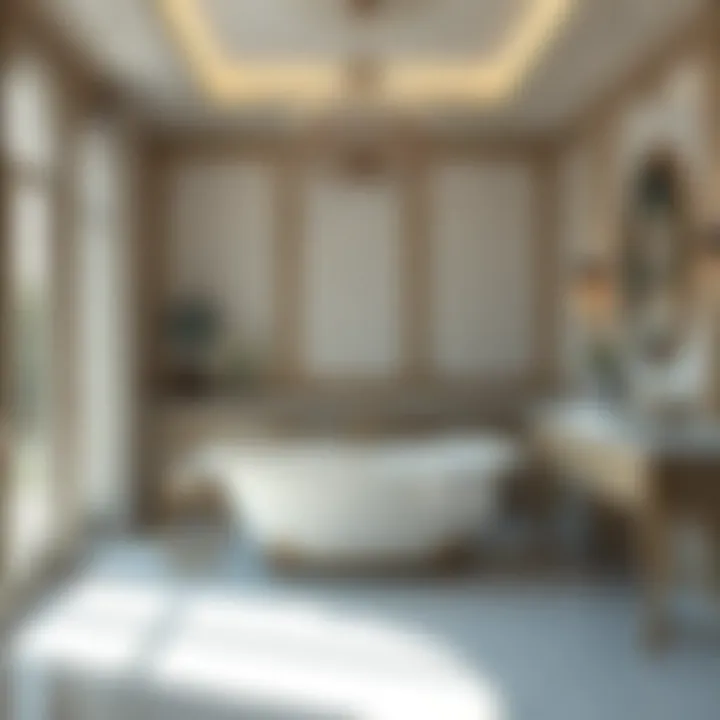
Proportion and scale relate to the size and relationship of different elements within a space. Understanding these aspects ensures that items fit comfortably without overwhelming the room. For example, a massive island in a small kitchen can create a sense of claustrophobia, countering the desired spacious feel. Conversely, using too small furniture in an expansive room can make it feel empty. These ere key considerations in interior design, as they maintain visual balance and aesthetics. Effective use of proportion and scale in design not only underpins visual appeal but also enhances usability.
By keeping these fundamental elements in mind, one can lay a solid groundwork for effective kitchen and bath design that embodies both practicality and style.
Essential Elements of Kitchen Design
When diving into the world of kitchen design, one cannot overlook the essential elements that breathe life into this pivotal space. A kitchen is not just a functional area for cooking; it is often the heart of the home, where family and friends gather. Understanding the essential elements of kitchen design is crucial as they influence not only the transparency of the space but also its usability and vibe.
Key elements such as cabinetry, countertops, and lighting serve dual purposes: enhancing both the aesthetic and functionality. From selecting the right cabinetry that reflects personal style to orchestrating the perfect balance of lighting for both task and ambiance, each choice plays a crucial role in the final masterpiece. For better interaction and usability, the design should not only accommodate cooking efforts but also resonate with comfort and style.
Cabinetry Choices
Cabinetry is often the star of the show in kitchen design. The right cabinets can transform a mundane cooking space into something that radiates elegance and practicality. When considering cabinetry, homeowners must ask themselves what style reflects their personality best. Options can range from sleek, modern finishes to rustic wood designs that evoke a homely feel. It’s essential to not only think about the style but also the storage needs of the kitchen. The more organized a kitchen is, the more efficient it becomes.
Countertop Materials
Countertops are fundamental not just for looks but also for durability and maintenance. Each material has its own set of characteristics that might affect a homeowner's choice.
Granite vs. Quartz
The debate between granite and quartz countertops is one that never seems to settle. Granite is a natural stone that offers durability and a timeless appeal. Its unique veins and patterns make each slab distinct, adding a hint of luxury to the kitchen. On the flip side, quartz is engineered, making it more uniform and available in a variety of colors and patterns. One unique feature of quartz is its non-porous nature, which limits staining and requires less maintenance compared to granite. However, granite enthusiasts often rave about its heat resistance, which can be a significant factor for avid cooks. Choosing between these two largely depends on the desired aesthetic, level of maintenance one is willing to commit to, and, of course, budget considerations.
Laminates and Wood Options
Laminates and wood are two other popular options that cater to various preferences and budgets. Laminates are often the go-to choice for homeowners looking for an economical yet stylish surface. They come in a wide range of colors and patterns, making them versatile for many design schemes. One key characteristic is their ease of maintenance, as they can be wiped clean without the worry of staining that comes with natural materials.
Wood countertops, on the other hand, provide warmth and an organic touch to any kitchen. They can be ideal for those who prioritize a cozy, rustic feel. However, this option tends to require regular oiling to maintain its luster and prevent warping. Homeowners must weigh the charm of wood against the practicalities of laminate to decide what suits their design vision best.
Lighting Considerations
Lighting is one of the most understated yet vital components of kitchen design. The right light can enhance all the carefully chosen elements in the kitchen, creating an atmosphere that welcomes you in. Effective lighting design needs to incorporate both ambient and task lighting. Under-cabinet lighting can illuminate prep areas, while pendant lights over an island can act as a statement piece. Every bulb and fixture should complement the overall design language of the kitchen, contributing not just to illumination but also to the emotional resonance of the space.
"Illuminate your kitchen not just for tasks but to transform it into a centerpiece of beauty and function."
Choosing the right lighting style brings energy into the room, making any kitchen more inviting and livable. As with other elements, a thoughtful approach to lighting can lead to a kitchen that feels bright and open, even in smaller spaces.
Key Features of Modern Bathrooms
When we talk about modern bathrooms, it’s not just a matter of aesthetics; it’s about blending form and function in ways that really enhance the day-to-day experience of using these vital spaces. As the line between functionality and luxury blurs, understanding key features becomes essential for both homeowners and enthusiasts alike. The thoughtful integration of elements such as bathing options, sustainable fixtures, and innovative storage solutions can significantly elevate the design and usability of the bathroom.
Shower and Bathing Options
Freestanding Tubs
Freestanding tubs are making waves in bathroom design—not literally, of course! These stunning features act as a centerpiece, providing both a practical and luxurious element. The main characteristic of freestanding tubs lies in their ability to stand alone, often lending a sculptural aspect to the room. This beneficial choice offers home dwellers a versatile way to create a spa-like atmosphere right at home.
One unique feature of freestanding tubs is their various shapes and sizes, allowing for customization that fits personal tastes and bathroom dimensions. Homeowners often delight in the wide selection available, from modern geometric forms to classic clawfoot styles. A freestanding tub can create a sense of openness in a small bathroom, making it feel less confined.
However, they do require a bit of a commitment when it comes to installation and plumbing, which might involve some upfront expense. Still, the benefits—like offering a relaxing retreat after a long day—often outweigh these concerns, making them a popular addition in modern designs.
Walk-in Showers
Walk-in showers are another key feature gaining traction. The key characteristic of these showers is their accessibility and freedom from barriers. Without need for a door or threshold, they create a seamless transition from the rest of the bathroom, making it feel larger and more inviting.
This design choice often includes features like rainfall showerheads, body sprays, and built-in shelving for toiletries, which enhances both practicality and luxury. One of the unique advantages of walk-in showers is their ability to incorporate various materials, like tiles and glass, allowing homeowners to tailor the aesthetic to their preferences.
On the downside, if not designed properly, they can lead to water splashes that may create a mess, especially in smaller spaces. Still, with smart design choices, walk-in showers serve as an excellent option that adds a contemporary flair and functionality to modern bathrooms.
Sustainable Fixtures
In recent times, sustainable bathroom fixtures have stepped into the spotlight, driven by a collective concern for the environment. Selecting products like low-flow toilets, water-saving faucets, and eco-friendly lighting systems not only helps in reducing water usage but also cuts down on utility bills. Such fixtures are not only functional but also make a strong statement about one’s commitment to sustainability.
With many modern designs focusing on eco-friendly solutions, homeowners can find fixtures that offer both style and efficient performance. Choosing the right fixtures can significantly lower a household’s ecological footprint, making it possible to enjoy luxury in an environmentally responsible way.
Vanity and Storage Solutions
When it comes to maximizing space and maintaining an organized bathroom, vanity and storage solutions take center stage. The main focus here should be on clever storage that conceals clutter while still being aesthetically pleasing.
Built-in cabinets, wall-mounted shelving, and multi-functional vanities offer ample options. A floating vanity can lend an airy feel, while still providing storage space underneath. The clever use of drawers and compartments can turn a simple vanity into a storage powerhouse.
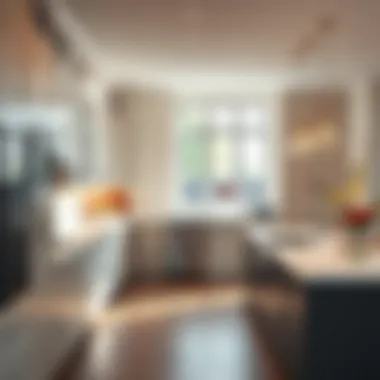
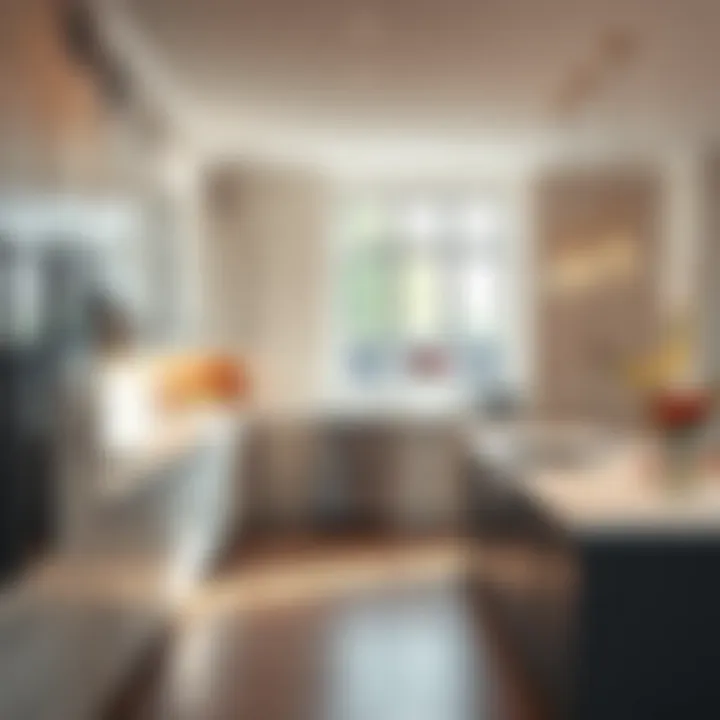
Moreover, features such as pull-out bins and built-in organizers allow for easy access to everyday essentials, helping to keep the bathroom looking tidy and inviting.
Incorporating Technology
In recent years, technology has embedded itself into the heart of kitchen and bath design, striking a balance between convenience and modern aesthetics. This section delves into the pivotal role that technology plays, examining how it enhances functionality and boosts efficiency. Homeowners are no longer just looking for beautiful spaces; they are seeking practical solutions that can streamline their daily routines. With the advent of smart devices and innovative fixtures, the sanctuary of home can also become a hub of intelligent living.
Smart Kitchen Appliances
Smart kitchen appliances are revolutionizing the way we cook and interact with our culinary spaces. Devices like smart refrigerators and ovens not only add an element of modernity but also simplify everyday tasks. For example, smart refrigerators can track the items inside, suggest recipes based on what's available, and even notify you when you're running low on essentials.
Additionally, smart ovens allow homeowners to control temperature settings or cooking times remotely via smartphones, which can be a real lifesaver during busy evenings. The integration of technology thus caters to time-strapped individuals who desire not just traditional functionality, but also a level of intuition in their appliances.
Innovations in Bath Technology
In the realm of bath technology, innovations like smart showers and automated lighting are changing the everyday experience into something more luxurious and enjoyable.
Smart Showers
Smart showers offer a unique approach to a common routine, merging hydration enjoyment with technology. These modern systems allow you to control water temperature, flow, and even shower duration through an app or voice command. One of the standout features here is the ability to pre-set preferences. Imagine stepping into the shower after a long day and finding the exact temperature already set for you.
"With smart showers, you're not just stepping into a spray of water; you’re entering a customized retreat designed to ease your stress."
This convenience is especially popular among users who appreciate a spa-like experience in their bathrooms. On the downside, reliance on technology could lead to complications if the system malfunctions, which might make some homeowners wary.
Automated Lighting
Automated lighting is another leap forward in bath technology, marrying ambience with energy efficiency. By installing smart lighting systems, homeowners can control light intensity and color through voice or touch. This feature is particularly advantageous for those looking to create a calming atmosphere. When you combine this with automatic dimming in response to natural light, the results can be charmingly serene.
However, potential downsides might include setup costs and the need for a consistent Wi-Fi connection. Homeowners should consider these aspects when planning their designs. Overall, the advantages of ease and enhanced ambiance tend to outweigh these concerns.
In sum, the incorporation of technology in kitchen and bath design not only hones in on aesthetics but also emphasizes convenience and smart living. With every new gadget released, it's crucial for homeowners to evaluate their choices carefully, ensuring that whatever technology they select enhances their experience rather than complicates it. It’s a balancing act, but one that embodies the essence of modern living.
Aesthetic Approaches to Design
Aesthetic approaches in kitchen and bath design play a crucial role in transforming spaces into inviting and functional sanctuaries. The way a kitchen or bathroom looks can drastically affect how one feels within these environments. An appealing design not only enhances the aesthetic value of a home but also influences the functionality and usability of the space. Interestingly, these areas should reflect personal style while also considering the practical aspects involved.
When homeowners approach the aesthetic design of their kitchens and bathrooms, several elements come into play. Let’s delve into how they can enrich the experience:
Choosing the Right Color Palette
The significance of a well-thought-out color palette cannot be overstated. Colors can dramatically impact mood and atmosphere. A warm color, like a soft beige or gentle yellows, can make a kitchen feel cozy and inviting. In contrast, cooler shades, such as blues and greens, can evoke a serene spa-like feeling in bathrooms.
- Tip for Selection: Start with a focal point in the room, like cabinets or countertops, and build around it.
- Consideration: Light plays a role. A room with plenty of natural light might benefit from deeper hues since they won’t feel overwhelming.
Additionally, consider using complementary colors. Pairing a navy blue with crisp white can establish a timeless elegance. As stated in various design sources, harmony in colors emboldens the viewer while comfort remains paramount.
Incorporating Textures and Patterns
Textures and patterns lend depth and character to any design. A flat surface can appear lackluster, but introducing varied textures can make a remarkable difference. Think of glossy finishes juxtaposed with matte ones; the contrast can create intrigue.
- Materials to Explore: Wood, metal, glass, and tile all offer diverse textures.
- Pattern Ideas: Geometric tiles can serve as a striking backsplash, while soft fabrics in curtains can soften the look of a modern space.
Textures are also instrumental in creating tactile experiences. For instance, a rough stone countertop can clash delightfully with plush fabric seating nearby. By considering tactile elements, homeowners can add richness to their kitchen and bathroom designs, ensuring they are as enjoyable to touch as they are to see.
Art and Decor Ideas
Art and decor are the finishing touches that personalize spaces, giving them life and character. Wall art can frame a kitchen area beautifully while decorative items, such as vases or cookbooks, can express individual taste.
- In the Kitchen: Incorporate open shelves to display colorful dishes or herbs in stylish containers for both decoration and utility.
- In the Bathroom: Items like wall hangings or even framed mirrors can elevate the look notably. Consider artwork that ties back to the colors in the room.
"Great design should feel effortless and evoke emotional responses, reflecting who you are as a person."
This encapsulates the aim: to make each space an authentic representation of the homeowner.
In summary, aesthetic approaches foster a harmonious blend of beauty, comfort, and individuality within kitchen and bath spaces. Through a carefully chosen color palette, varied textures, and thoughtful decor, these areas can truly become personal havens.
Trends in Kitchen and Bath Design
Keeping up with trends in kitchen and bath design is crucial for creating spaces that not only reflect personal style but also cater to modern needs. These trends often emerge from a combination of functionality, aesthetics, and sustainability. As homeowners increasingly seek to upgrade their living spaces, understanding these trends ensures a maintained value of the property, while also enhancing daily living. Let's explore some significant elements of these trends and why they're relevant today.
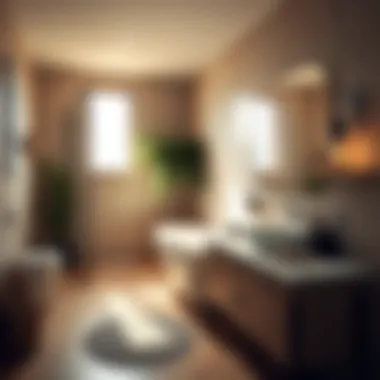
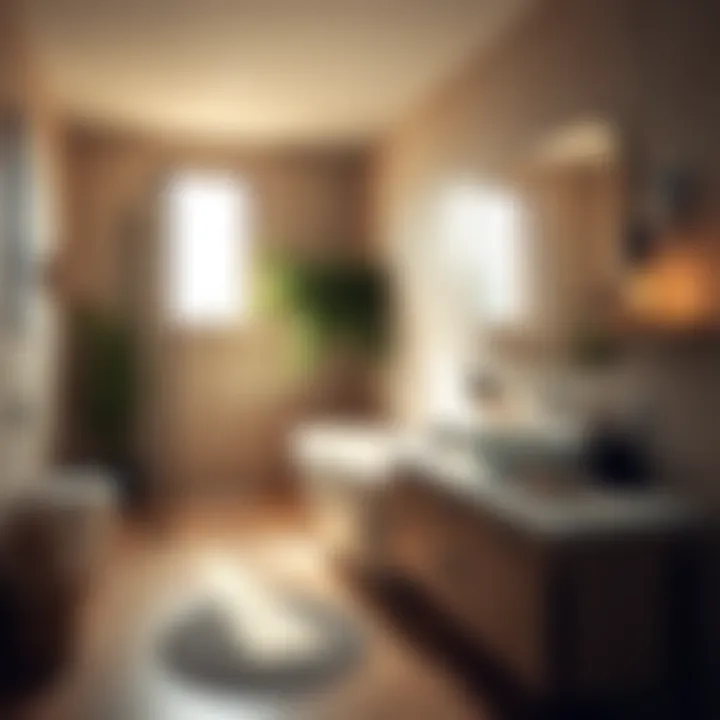
Sustainable and Eco-Friendly Designs
Sustainability isn’t just a buzzword; it’s become a guiding principle in home design. Homeowners are becoming more conscious about their environmental impact, which has spurred an increasing demand for eco-friendly materials and practices in kitchens and baths. This shift includes choosing products like low-VOC paints, energy-efficient appliances, and sustainably sourced cabinetry.
- Consideration of energy consumption during renovations is paramount. For instance, Energy Star-rated appliances help reduce both environmental impact and utility bills.
- Using recycled materials for countertops or tiles provides durability and a unique flair. Brands like Caesarstone feature options that integrate post-consumer materials, ensuring that style and sustainability go hand in hand.
Incorporating eco-friendliness into designs not only conserves resources but also contributes to healthier living environments.
Open-Concept Spaces
Open-concept design is gaining traction as it encourages collaboration and social interaction within the home. This trend aligns well with lifestyle shifts as many people prefer spaces that feel more interconnected. In kitchens and baths, this means blurring the lines between various living areas.
- Imagine a kitchen that seamlessly flows into the living room, making it easier for families to spend time together while cooking or entertaining. This layout encourages communication and makes the most of available space.
- However, this design approach does come with its challenges. Homeowners must consider decor cohesion and functional zoning. For instance, it’s essential to maintain clear separations in decor styles and color schemes to avoid chaotic aesthetics in an open space.
Minimalist versus Maximalist Trends
When it comes to design philosophies, minimalism and maximalism seem to be at odds, yet they are both prevalent in modern kitchen and bath spaces. Understanding their nuances can help homeowners select a style that resonates with their personal preferences and the overall vibe they wish to create.
- Minimalism focuses on simplicity, function, and decluttered spaces. Think sleek cabinetry, neutral color palettes, and minimal decoration, which promotes tranquility and ease of maintenance. Brands like IKEA often embody these minimalist ideals with their smart storage solutions and clean designs.
- On the other hand, maximalism celebrates abundance and personality. This trend allows for vibrant colors, bold patterns, and a mash-up of textures. Homeowners can embrace their individuality through unique backdrops and statement pieces.
Both styles can be synthesized; a minimalist space can benefit from indulging in a few maximalist elements, such as a striking backsplash or colorful decor to add depth and interest without overwhelming the senses.
"The kitchen is the heart of the home, and these trends help craft a space where function meets lifestyle."
In essence, the trends in kitchen and bath design reflect broader cultural shifts and individual preferences. With each observer and participant in these trends, from sustainable materials to layout options, the evolution continues, paving the way for innovative and personalized spaces.
Practical Maintenance Tips
Keeping your kitchen and bath in tip-top shape goes beyond just picking the right colors or the latest fixtures. Practical maintenance is crucial to ensuring that these spaces remain functional and beautiful over time. Regular upkeep can prevent costly repairs, extend the life of your installations, and ensure that you're creating a welcoming environment for family and guests alike. In bustling households, where every surface tells a story, understanding how to maintain your spaces isn't just practical; it's essential.
Cleaning and Upkeep for Kitchens
A well-maintained kitchen is the heart of the home, where meals are prepared and memories are made. Here are some important tips on how to keep this space spick and span:
- Daily Wiping: Get in the habit of wiping down countertops and tables after each meal. Not only does this keep things looking orderly, but it also prevents bacteria buildup, especially on surfaces that often come in contact with food.
- Deep Cleaning: Schedule a deep clean every month. This includes scrubbing cabinets, appliances, and floors. Pay special attention to areas behind the fridge and under the stove, as crumbs and spills can hide out of sight.
- Stove Maintenance: Remove and clean grates and burners regularly. A simple solution of vinegar and water can work wonders for stubborn grease.
- Dishwasher Tips: Run your dishwasher on an empty cycle with a cup of vinegar to keep it updated and fresh. This will prevent hard water buildup and maintain efficiency.
"Cleaning is not just about removing dirt; it's about creating an environment that promotes health and well-being."
By following these simple steps, you won't just be cleaning; you'll be maintaining a sanctuary for culinary creativity in the kitchen.
Maintaining Bathroom Fixtures
Bathrooms are often neglected when it comes to regular maintenance, yet they're subject to moisture that can cause damage over time. Focus on maintaining your bathroom fixtures to prevent deterioration:
- Faucet Care: Regularly check for drips or leaks around faucets. A small leak can waste gallons of water over time. Tighten connections and replace washers as needed. Cleaning faucets with a soft cloth and a mixture of vinegar and baking soda will keep them shining and free from corrosion.
- Showerheads: Mineral buildup is common in showerheads. To clean them, fill a plastic bag with vinegar and secure it over the showerhead with a rubber band. Leave it to soak overnight to dissolve the minerals.
- Grout Maintenance: Keep grout lines clean and free from mildew by using a mixture of hydrogen peroxide and baking soda. Apply it to the grout, let it sit, and scrub with a toothbrush.
- Mirror Surfaces: To avoid streaks, clean mirrors with a mixture of equal parts vinegar and water. This will leave your mirrors crystal clear.
Keeping your bath spaces tidy and well-maintained isn't just about looks—it’s about enhancing the overall experience of relaxation and hygiene.
Taking the time to focus on practical maintenance tips can transform your kitchen and bath into spaces that not only impress but also function seamlessly in your day-to-day life.
Final Thoughts on Kitchen and Bath Enhancements
In the realm of home design, kitchen and bath enhancements transform ordinary spaces into remarkable environments. These areas are not merely functional; they serve as the heart and sanctuary of a home, where daily life unfolds. The decisions made in these areas create lasting experiences that resonate with every family member.
The importance of focusing on kitchen and bath enhancements lies in their combined impact on home value and personal well-being. A well-designed kitchen is the heart of family gatherings, a space where memories are crafted over meals and conversations. Similarly, a relaxing bathroom can serve as an oasis, enabling individuals to recharge and reflect.
Why Prioritize Enhancements
- Increased Property Value: Many buyers will prioritize kitchens and bathrooms when searching for a home. Investing in these areas can significantly raise marketability and property prices.
- Enhanced Functionality: Thoughtful enhancements lead to improved workflows. For instance, optimizing cabinetry layout can yield a smoother cooking experience.
- Aesthetic Appeal: Making aesthetic changes can invigorate a space, aligning it with modern trends and personal preferences, thus sparking joy and satisfaction.
Moreover, engaging with trends in sustainability can turn ordinary kitchen and bath designs into pillars of eco-friendliness. By choosing materials like bamboo or recycled composites, homeowners not only improve their homes but also contribute positively to the environment.
"Home is where we should feel secure and comfortable, but that comfort can be dramatically influenced by the design choices we make in our kitchens and bathrooms."
Considering Future Trends
As the design landscape continually evolves, it’s essential to stay abreast of upcoming innovations. Technology integration, for instance, reshapes how we interact with our spaces. Smart technology in the kitchen or bathroom can enhance convenience and control costs with energy-efficient solutions. Moreover, personalization is becoming a significant aspect of modern design, as homeowners prioritize customizing spaces to reflect their unique lifestyles and preferences.
In sum, investing time and resources into kitchen and bath enhancements pays dividends far beyond aesthetics or functionality alone. It positions the home for future appreciation while ensuring each space fulfills its role as a vital part of daily life. These improvements forge deeper connections to our homes.
Resources for Further Exploration
- Explore kitchen and bath design trends in detail at Britannica.
- Join discussions on current design challenges or successes on Reddit.
- For design inspirations and communities, visit platforms like Facebook.
Ultimately, the choices made today shape the legacy of our kitchen and bath spaces tomorrow, summoning both excitement and responsibility in the journey of home enhancement.



